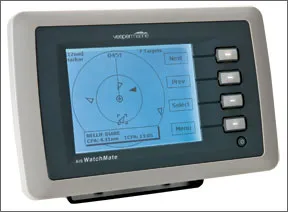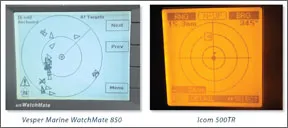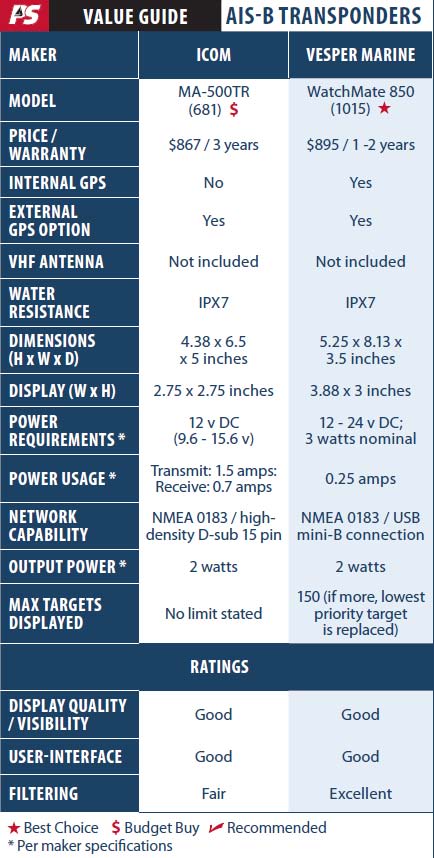The popularity of Automatic Identification Systems (AIS) has grown exponentially in recent years, particularly among small- to mid-sized cruising sailboats. Lower costs have played a big hand in this, as has increased participation (the more boats with AIS, the more boats there are to see); however, the primary driver remains boat owners looking to increase safety.

Photo by Frank Lanier
AIS transceivers help skippers navigate high-traffic areas by painting an overview of marine traffic and providing important information about nearby commercial ships and other vessels that are AIS-equipped. AIS is a seemingly simple system that transmits dynamic information about a vessels speed, course, and position plus static information including the vessels name, call sign, and Mobile Maritime Service Identity (MMSI) number over marine VHF frequencies.
AIS transceivers are split into Class A (commercial) and Class B (recreational), and they broadcast information from every 2 to 30 seconds. Class A transceivers have a maximum VHF power output of 12.5 watts, are required to broadcast more data than Class B units, and must update data more frequently than Class B. Class B transceivers are designed to provide a similar yet limited service, at a lower cost, to smaller vessels not required to carry a Class A unit. Class B units transmit less data at a slower rate using a 2-watt transmitter. AIS listen-only devices, like the Raymarine AIS250 and SI-TEX/Nasa Marine receiver we tested (March 2007), receive AIS broadcasts but do not transmit any information.
Class B transceivers relay vessel information, position data, course over ground, speed over ground, heading, status, and even offer a means of direct dialing another boat via VHF channels by utilizing a provided MMSI number and select VHF channels. For specifics on the AIS broadcast data types and frequencies, check out this article on www.practical-sailor.com.
While not a replacement for radar, AIS benefits from the propagation characteristics of VHF, allowing it to see around and behind objects such as large ships, small islands, rocks, etc.-assuming whatever is behind these objects is equipped with AIS.
AIS transceivers can be useful search-and-rescue tools. Like an activated EPIRB, they offer the Coast Guard and other rescue personnel the boats exact location and amplifying information. They also can be used to track the latest generation of AIS-based man-overboard beacons like those we reviewed in the May 2013 issue.
Our last look at AIS units was in September 2009, when we evaluated the Navico NAIS-300 and the West Marine AIS1000. Both were Class B devices capable of sending and receiving AIS data. Each relied on compatible chartplotters, multi-function displays, or PCs to display their information. The NAIS-300 received a Recommended rating, while the AIS1000 was named Budget Buy.
In our August 2010 issue, contributor Joe Minick reported the pros and cons of using an AIS receiver with a PC display as a collision tool while cruising near Turkeys Dardanelles Strait. Fast-forward three years (a lifetime in the world of electronics), and standalone AIS units with integral displays have come into their own, at comparable prices to the non-display units we tested previously.
What We Tested
Our latest evaluation compared Class B transceivers from two key players in the AIS market. From Icom, a global company whose product line includes communications equipment and products based in the marine, avionics, land mobile, and wide-band receiver industries, we tested the MA-500TR. New Zealand-based Vesper Marine, a relatively new company that has steadily garnered a worldwide reputation for quality and innovation, submitted its WatchMate 850 for testing.

Photo courtesy of Icom
Both transponders will pick up signals from AIS-equipped search-and-rescue transponders (SARTs) or man-overboard (MOB) beacons, but how they display the signals may differ. The WatchMate 850 clearly explains that these distress signals are displayed with a special icon and an alarm will sound, but Icom does not address it in the MA-500TRs owners manual. We were unable to test this or to get confirmation from Icom, but its likely the SART icons appear like other AIS targets.
AIS transponders use GPS signals to get position data and VHF signals to send and receive other data. Of our test products, only the WatchMate 850 features an internal GPS antenna. The 500TR must be networked with a chartplotter to get position data. Neither of the tested AIS transponders comes standard with a VHF antenna, so users have two choices: Buy and install a dedicated VHF antenna for the AIS device or use a splitter to connect the transceiver to an existing VHF-radio antenna. Depending on the hardware, this latter option could potentially affect signal strength. Vesper Marine offers a specialized AIS/VHF splitter, the SP160, which the company claims has no signal-strength loss. (We recently tested the SP160 and will be reporting on it in an upcoming article.) Other companies like West Marine and Digital Yacht also market splitters designed for AIS connections, but we have not yet tested them.
For advice on where to mount an AIS-VHF antenna, click here.
How We Tested
The Icom and Vesper Marine units went head-to-head in bench tests and field tests while cruising the waters of Hampton Roads, Va., an AIS-target hotspot with a steady stream of recreational, commercial, and military vessels.
The products were rated on AIS functions, control capabilities, user-interface, filtering capability, display quality, and screen visibility, both belowdecks and in bright sunlight. Other rating considerations included power consumption, networking ability, water resistance, ease of use, and installation requirements; price and warranty also were factored in final ratings.
Unlike VHF radios, transmitting on the AIS devices is automatic, low-wattage, and too fast for testers to effectively measure power output or consumption while transmitting, so we relied on manufacturer-provided measurements for these specs. (See Value Guide.)
Icom 500TR
The MA-500TR (681) is a Class B AIS transponder designed for non-SOLAS vessels (non-commercial pleasure craft, work boats, and small vessels, etc). The 500TR receives dual AIS channels (87B and 88B) simultaneously and receives both Class A and Class B AIS information. Vessel information (boat MMSI, name, type, position, speed, course, etc.) is automatically transmitted at fixed intervals or under base station control.
The 500TR features a full dot-matrix display with adjustable backlight and contrast. It looks similar to a mini-radar display with north-up and course-up options, as well as display ranges from 0.125 nautical miles to 24 nautical miles.

Photos by Frank Lanier and courtesy of Vesper Marine
The front of the 500TR has 11 pushbuttons that control various functions. These include a dedicated MOB button, an essential feature on chartplotters and handy feature on AIS units. Pressing the 500TRs MOB button drops a waypoint flag icon that you can steer back to. The power button serves double duty, also providing easy adjustment of display brilliance and contrast. All of the controls and their respective functions were fairly intuitive and straightforward.
Operationally, the 500TR has a number of collision-risk management functions, such as a list of local targets, as well as a danger list of targets you could potentially collide with. The Target list shows all detected AIS-equipped vessels and targets sorted by distance, from closest to farthest; this is updated every 5 seconds.
The Danger list shows all vessels within 6 nautical miles CPA (closest point of approach) and 60 minutes TCPA (time to CPA) from your vessel. These parameters are not user-adjustable; however, they can be sorted by CPA or TCPA. The CPA is user adjustable between 0.1 and 6 nautical miles, in 0.1 nautical miles increments, while the TCPA can be adjusted from 1 to 60 minutes, in 1-minute increments. Additionally, the Detail screen shows all available information about the selected AIS target (name, MMSI, etc).
As a target vessel enters the CPA / TCPA range, its displayed icon blinks and an alert beep is sounded; an external speaker can be added to make the collision alarm easier to hear when away from the unit.
The 500TRs compact size and waterproof rating (IPX7, or submersible to 3 feet for 30 minutes) mean it can be mounted at the helm, in the cockpit, or belowdecks at the nav station. Testers found the 500TR display easy to read belowdecks, in direct sunlight, and while wearing polarized sunglasses. Backlighting and contrast adjustments were easy to use and effective.
When connected to a compatible Icom VHF radio, the 500TR provides an easy means of making individual DSC calls to another boat without having to manually input MMSI numbers. Simply select a vessel using the cursor keys, then push the 500TRs DSC button.
Other 500TR features include the ability to store up to 100 waypoints in memory and to receive, display, and store DSC safety-related messages from Class A AIS transponders (up to 20 automatically stored in memory).
The back of the unit contains connectors for a GPS receiver, VHF antenna, power connections, and an NMEA plug. The 500TRs data output uses the NMEA 0183 format for easy connectivity to most current radars, chartplotters, and navigation systems. Theres also a cloning cable receptacle that allows users to connect the unit to a computer, conceivably creating a repeater display.
For troubleshooting and operational checks, the 500TR has a diagnostics page that allows you to check both monitor operation and transponder health.
Another useful feature is that the transmit function can be turned off, essentially converting the 500TR to a receive-only unit. This is done by pressing down the left and right arrow keys simultaneously until a transmit off message appears on the screen; to resume transmitting, simply reverse the process; we did not find directions for doing this in the owners manual.
The 500TR comes with an external GPS antenna, a NMEA connector cable, mounting bracket kit, and DC power cable.
Bottom line: The 500TR has a lot to offer, including a three-year warranty, but when compared to the WatchMate 850, its limited target-filtering ability and its external GPS antenna requirement held it back. But, its almost $100 less than its competitor (and costs less than some current display-less Class B transceivers), so it gets the Budget Buy pick.
Vesper Marine WatchMate 850
A driving philosophy behind the WatchMate 850 is the ability to reduce screen clutter by focusing on important targets. Target filtering is based on a user-selected combination of target speed, range, CPA, and TCPA, enabling users to reduce screen clutter by filtering targets that are moored, stationary, or moving away. Alarm and filter settings are grouped into profiles (harbor, coastal, offshore, etc.) and can be activated with a single selection. This allows you to pre-set set the various parameters to suit your preferences, then toggle between the groups as desired.
Targets are organized by collision-risk priority, with higher-risk targets at the top of the list, and can be stepped through in order of preference, as can the complete list of targets.
With great filtering options comes great responsibility to ensure targets of interest are not inadvertently filtered out by setting values too high (speed, for example) or too low (say, for range). Testers liked that the total number of targets tracked is always displayed, regardless of how aggressively you have them filtered. They also liked that when viewing a targets details, a press of the CPA button displays a plot showing the targets relative position to your vessel, at the time of their closest point of approach. This allows users to see whether a crossing target will pass ahead or astern. While the 500TR displays the CPA of a selected target, the WatchMate 850 actually advises you on whether to turn port or starboard to avoid a potential collision.
Unlike the Icom, the WatchMate 850 features an internal GPS receiver and GPS patch antenna, which greatly simplifies installations with a clear view of the sky; an optional externally mounted GPS antenna can be purchased for belowdeck installations. Testers marveled at the compact size of the WatchMate external GPS antenna, especially compared to the 500TRs GPS antenna.
Another useful tool is the anchor watch feature. Using heading information, the WatchMate 850 determines the location of the bow when dropping the hook, providing greater accuracy than just using the position of the GPS antenna (which is typically located at the stern). Theres also a screen that lets you fine-tune the physical location of the GPS antenna, providing even greater accuracy.
The WatchMate 850 can broadcast and receive safety and emergency messages to and from all AIS-equipped vessels within VHF range. It can also be placed in silent mode, which keeps the AIS and GPS receivers operating normally but switches off the automatic transmission of your vessels position and details, rendering the device a listen-only unit.
Like the 500TR, the 850 can initiate direct DSC calls to a target when connected to a compatible VHF radio without the need to manually enter MMSI numbers. Its USB connection also means it can easily be connected to onboard computers, providing both GPS and AIS data to any PC charting application.

Testers liked the AIS Status screen, which provides a host of information that can be used to verify proper operation or while troubleshooting. Additionally, the WatchMate 850 continuously monitors its transceiver performance, and if a problem is detected, an error alert pops up on the display and an audible alarm sounds.
The WatchMate 850 does not have a dedicated MOB or waypoint-entry button; in fact, there is no mention of any waypoint or MOB entry features in the owners manual. Its a feature we liked on the 500TR, and one that would be a good addition to the WatchMate, in our opinion.
The 850 is advertised as being compatible with all AIS search and rescue / MOB devices. If an AIS-SART or AIS-MOB is triggered, the WatchMate 850 sounds an alarm, displays a special icon, and provides continuous position updates as well as bearing and range to the SART or MOB. It can also be configured to activate an external alarm, buzzer, or other indicator.
The WatchMate has four control buttons and a power button. The control buttons grant access to a soft-key user interface designed to provide faster access to functions with fewer button pushes than a traditional menu-driven interface.
The fear with any piece of gear combining numerous functions with few control buttons is that operation beyond the basics may not be particularly intuitive. Testers were pleasantly surprised at how easy it was navigate the WatchMates menus without reaching for the manual, even when drilling down to the more advanced functions.
The rear of the WatchMate 850 has plugs for connection to an external GPS, VHF antenna, NMEA input/output connections, and a waterproof USB connector-the latter two allow you to integrate the AIS data into chartplotters or computer-based tracking systems respectively.
The WatchMate 850 features an easily viewable, grayscale, LCD display with adjustable backlighting and contrast, and a display range from 0.25 nautical miles to 48 nautical miles. Its screen is significantly larger than the 500TR. Even though some screen area is taken up by the soft keys (displayed along the right side), theres still a lot of dedicated display area remaining for a unit of this size. Testers found the display easy to read in al lighting conditions.
The WatchMate 850 is rated IPX7 like the 500TR, so it too is a good candidate for below- or above-deck installations. The package includes a protective cover, bracket and flush mount hardware, USB data cable, and a CD with the owners manual and other assorted data.
Bottom line: The WatchMate 850 provides a wealth of user-adjustable settings and customizable options with regards to AIS filtering and display. The ability to prioritize targets based on CPA, TCPA, bearing, range, etc., is a definite plus in the war on screen clutter. Its our Best Choice for an AIS-B unit with an integral display.
Conclusion
Both the 500TR and the WatchMate 850 performed as advertised and will allow users to detect, track, and (hopefully) avoid other AIS-transmitting vessels. Screen clutter can quickly become an issue when navigating a busy harbor, however, and the WatchMate 850 had the upper hand in resolving this challenge.
Vespers WatchMate 850 simply brings a lot more to the table in terms of features, options, and display customization than the 500TR. Its numerous targeting options allow users to reduce target overload and see the forest in spite of all the trees, so to speak. Testers also like that it has an internal GPS and like the 500TR, it can easily be patched into existing VHF antennas.
The Icom 500TR is a solid, well-built unit that works well and is intuitive. Extensive filtering options will not be as much of a priority for sailors who don’t frequent crowded harbors-or may not be worth the extra $100-and for those boat owners, the 500TR, our Budget Buy pick is worth considering.
Regardless of the unit that best suits your needs, AIS is arguably the most important collision-avoidance tool to hit the maritime world since the advent of radar. It doesn’t give you X-ray vision, but it can sure seem that way when monitoring AIS-equipped vessels located behind headlands, larger targets, and other traditional radar-blind spots.
The keywords here of course are vessels equipped with AIS. Despite AISs growing popularity, there are still a large number of vessels out there with neither the mandate nor desire to have AIS onboard, including a high percentage of the worlds small craft and military vessels.
Prudent seamanship practices (such as maintaining a proper watch) and radar should be your first line of defense against collisions. AIS is a powerful anti-collision tool, but it should be only one of multiple instruments in your navigational toolbox, one that is used with full knowledge of its limitations.






































The last time you’ve looked at AIS units was 2009 what kind of crap is that you need to update this right away this is completely ridiculous so, after all these years, you haven’t done a second review.14 years Between reviews is shameful. I’m not going to renew my subscription.